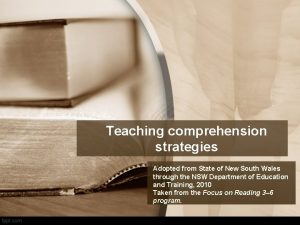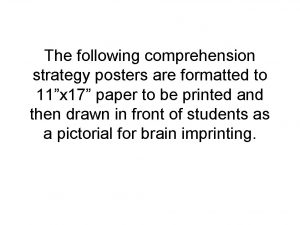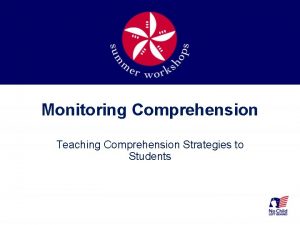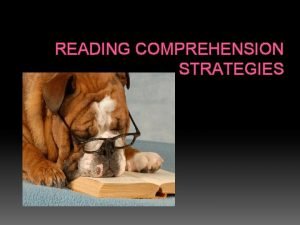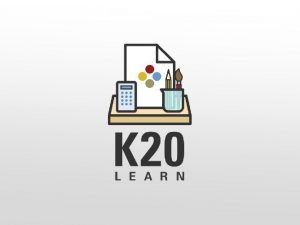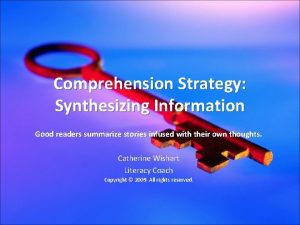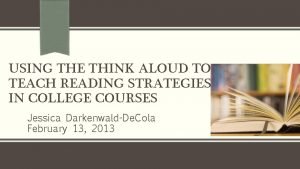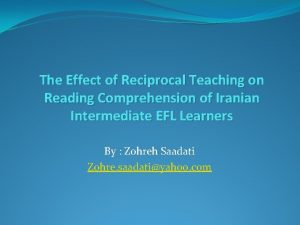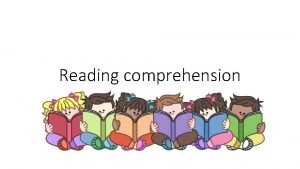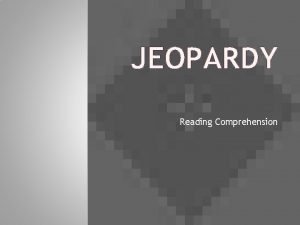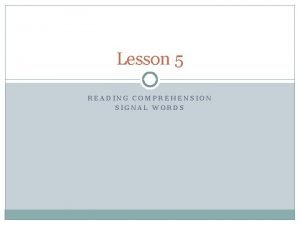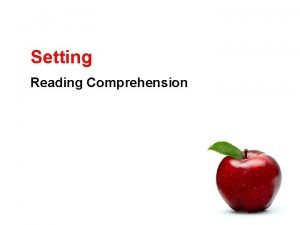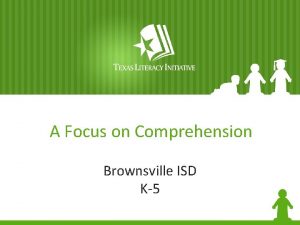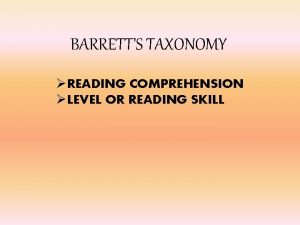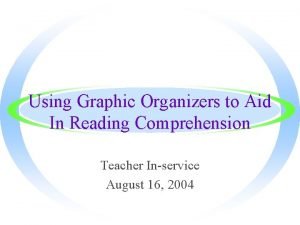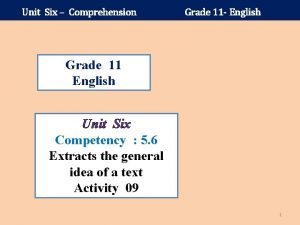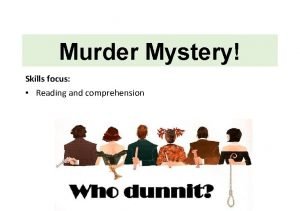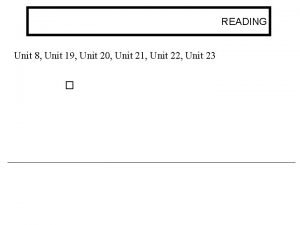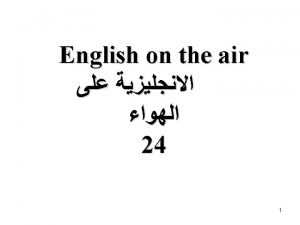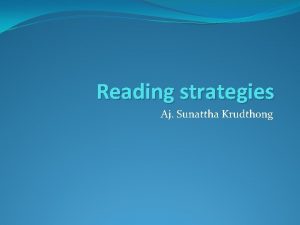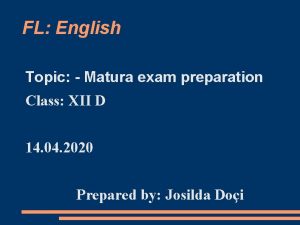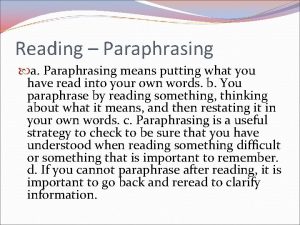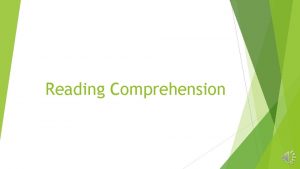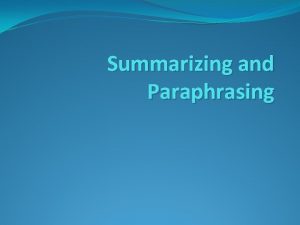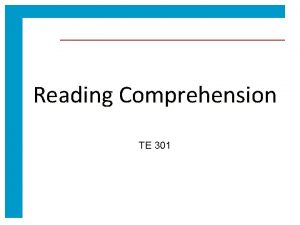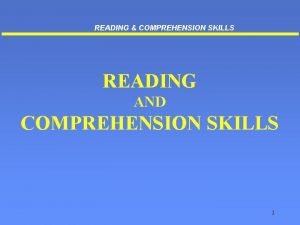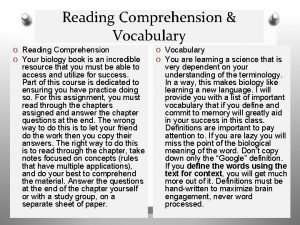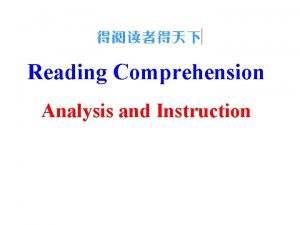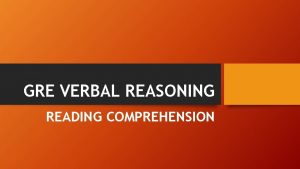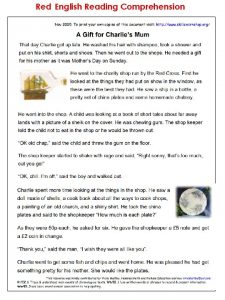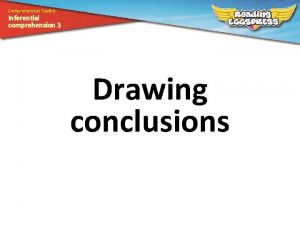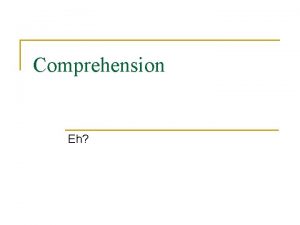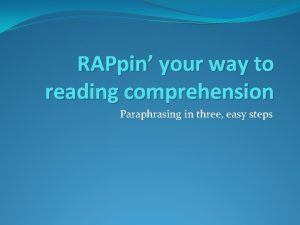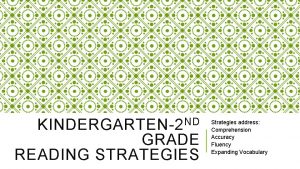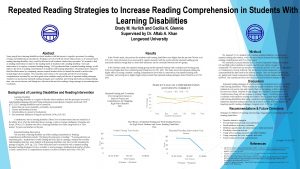READING COMPREHENSION STRATEGIES PARAPHRASING n Paraphrasing is putting

























- Slides: 25

READING COMPREHENSION STRATEGIES

PARAPHRASING n Paraphrasing is putting the ideas of an author into your own words to describe something you’ve read. Restating a text in words that you understand makes the meaning more clear and concise.

PARAPHRASING- HOW TO DO IT! Thoroughly read the original source until you get the main idea. n Then, try and put the main idea(s) into your own words. n You can change the structure and order of the content, but not the meaning. n Cut out the extra stuff and just write down the basics. n

PARAPHRASING EXAMPLE Example: It was a glorious spring day in May and my three sisters, my dad, my best friend and I decided we should enjoy the day. So, we packed our large red picnic basket full of sandwiches, cookies, lemonade and apples. The sun was shining as we pulled up to Carpinteria State Beach for a picnic by the water.

PARAPHRASING Example n Paraphrased: One day in May, my family and I went to Carpinteria State Beach to have a picnic.

PARAPHRASING- HOW TO DO IT! n Bullet points help order events or ideas. n Replace difficult words with words you understand (synonyms). Use a thesaurus or dictionary to help with this!

PARAPHRASING EXAMPLE YOU TRY! (make sure you figure out those difficult words!) We are surrounded by evidence that bullying has been taken to a much more destructive level with the proliferation of technology in the lives of kids.

PARAPHRASING Example n Example: We are surrounded by evidence that bullying has been taken to a much more destructive level with the proliferation of technology in the lives of kids. n Paraphrased: Evidence shows that bullying has gotten worse with the growth of technology.

PARAPHRASING- HOW TO DO IT! n Rewrite lengthy or complex sentences into simpler sentences or combine many sentences into one. n Explain difficult abstract concepts by using examples YOU can understand relate to.

PARAPHRASING: YOU TRY! n American alligators live in the wild in the southeastern United States. You're most likely to spot them in Florida and Louisiana, where they live in rivers, lakes, ponds, swamps, bayous, and marshes. These reptiles are kind of clumsy on land, but they're built for life in the water. Great swimmers, they are equipped with webbed feet and strong tails that propel them through the water.

PARAPHRASING: YOU TRY! American alligators live in the south eastern US (mainly in Florida and Louisiana) in swamps, rivers, lakes, etc. n They are great swimmers with webbed feet and strong tails that push them through the water. n

Reciprocal Reading Activity Pairs/Small Groups n 1. Students read in pairs or small groups, alternating between out-loud reader and silent reader. n 2. Out-loud reader will read one paragraph (approx. ) and pause. n 3. Silent reader will follow along and paraphrase/annotate. n 4. Both readers stop and share their notes. n 5. Out-loud reader and Silent reader add any ideas they discuss in 3 and 4. n 6. Students switch roles and repeat steps 2 and 3.

ANNOTATION n n Instructions n CIRCLE unknown and unfamiliar words as you read. You may need to come back and reread the sentences before and after the word to get at the meaning of the word. Write a brief definition in the margin when you get it. n Underline, highlight or circle sentences that provide you with definitions of key terms. Write "Def" in the margin so you can locate the definition quickly.

ANNOTATION n n n Put a STAR next to a sentence that provides an important example or a main topic. Draw a QUESTION MARK beside a point that is confusing. Make notes to yourself in the margins. As you read, write any questions or comments that crop up in your mind in the margin next to the passage. Put this into your own words as much as possible.

MACVIPS: Strategy for Annotating/Active Reading n n n n Main Idea: Main ideas found in the story. Ask questions: What you don’t understand & what you want to know. Comment: Summaries, reactions, connections. Vocabulary & Visualize difficult concepts or important ideas and define new vocabulary. Inference: Draw conclusions based on evidence in the text. Predict what might happen next. Self-monitor your understanding of the text and use fix-up strategies when confused.

The Basic CATCH Acronym n C – Circle and DEFINE words you do not know. A – Acknowledge confusion. You may not understand what you are reading AT FIRST, but you will if you keep going and do all the letters in CATCH. T – Talk to the text. C – Capture the main idea/assertion. n H – Highlight important information. n n n

TALK TO THE TEXT n Possibilities: – – – PREDICT based on what you already know… QUESTION (What don’t you understand? What do you need to know? ) COMMENT (What’s YOUR opinion? Is it different from the author? ) REACT (emotional or intellectual) CONNECT to other texts, other classes, personal or world knowledge

Headline Students work in groups to summarize the days lesson, unit or chapter by turning it into a newspaper article and/or articles. Students present paper to class and vote on best newspaper headline/article s. .

Strategy: Give and Take n n n Provides students with opportunities to utilize Academic Language Academic Sentence Frame: “ In our last session I learned that _______” Remind partners to use sentence frame if they forget. 19

Parallel lines n Rules: Stand across from a partner and “give and take one” for one minute until teacher tells you to stop. Then, one side moves down the line by one spot while the other remains still. Repeat process.

Eye Appointments 21

Strategy: Snowballs 22

True or False “As a punishment, bullies should be treated the same way they treat others. ” T or F? If false, Make this true.

Exclusion Brainstorming Yiddish automotive production Folklore Hebrew Ethnography Oral Tradition Fusion Barometric Pressure Tradition Reparations The Great Depression Torah status

RAFT Role Audience Format Topic
 7 reading comprehension strategies
7 reading comprehension strategies Super 6 reading strategies
Super 6 reading strategies While reading activities
While reading activities Super six comprehension strategies nsw det
Super six comprehension strategies nsw det Comprehension strategies posters
Comprehension strategies posters Monitoring comprehension strategies
Monitoring comprehension strategies Paraphrasing reading strategy
Paraphrasing reading strategy 4-2 reading quoting paraphrasing and summarizing
4-2 reading quoting paraphrasing and summarizing Reading strategies synthesizing
Reading strategies synthesizing How to teach reading comprehension
How to teach reading comprehension Explain reading comprehension
Explain reading comprehension Reading comprehension birthday party
Reading comprehension birthday party Jeopardy main idea
Jeopardy main idea I were you i would
I were you i would Agenda reading comprehension
Agenda reading comprehension Reading comprehension setting
Reading comprehension setting K5 reading comprehension
K5 reading comprehension Reorganization comprehension
Reorganization comprehension Story maps for reading comprehension
Story maps for reading comprehension Grade 11 reading comprehension
Grade 11 reading comprehension Murder mystery reading comprehension
Murder mystery reading comprehension Reading comprehension
Reading comprehension Modals reading comprehension
Modals reading comprehension It is stated in the reading that opera
It is stated in the reading that opera Matura exam english
Matura exam english Advantages of scanning in reading
Advantages of scanning in reading



